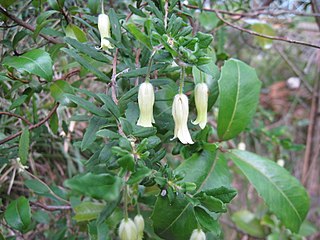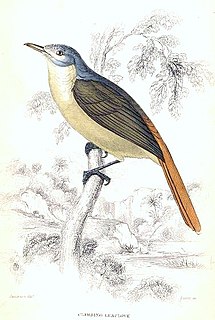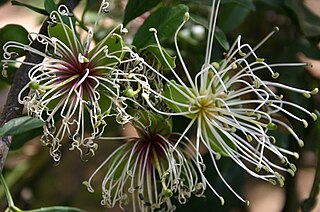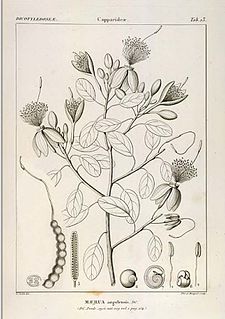
Austrobaileya is the sole genus consisting of a single species that constitutes the entire flowering plant family Austrobaileyaceae. The species Austrobaileya scandens grows naturally only in the Wet Tropics rainforests of northeastern Queensland, Australia.

Mikania is a genus of about 450 species in the boneset tribe within the sunflower family.

Hibbertia scandens, the snake vine, climbing guinea flower, golden guinea vine or gold guinea plant, is a species of flowering plant in the family Dilleniaceae, native to Australia but widely cultivated. Growing to 4 m (13 ft) in length, it is a climbing or sprawling evergreen shrub with glossy leaves and solitary, bright yellow flowers.

Billardiera scandens, commonly known as apple berry or apple dumpling, is a small shrub or twining plant of the Pittosporaceae family which occurs in forests in the coastal and tableland areas of all states and territories in Australia, apart from the Northern Territory and Western Australia. It has a silky touch and appearance that becomes more brittle as the dense growth matures. The inflorescence consists of single or paired yellow flowers, pink-tinged yellow sepals and bright yellow petals and is attached to a hairy drooping peduncle. The summer flush produces fruit of oblong berries up to 30 mm long, initially green in colour and covered in fine hair - somewhat akin to a tiny kiwifruit in appearance.

The red-tailed leaflove is a species of leaflove in the bulbul family, Pycnonotidae. It is found in western and central Africa.

The common cactus finch or small cactus finch is a species of bird in the Darwin's finch group of the tanager family Thraupidae. It is endemic to the Galapagos Islands, where it is found on most islands, with the notable exception of Fernandina, Española, Genovesa, Darwin and Wolf. Most of these islands are inhabited by its close relative, the Española cactus finch.

Maerua is a genus of plants in the family Capparaceae, with its centre of diversity in Africa, though some species extend their range as far north as the Levant, and as far east as the Indian subcontinent. Among its species:
Maerua elegans is a species of plant in the Capparaceae family. It is endemic to the Democratic Republic of the Congo. It is threatened by habitat loss.
Maerua crassifolia is a species of plant in the Capparaceae family. It is native to Africa, tropical Arabia, and Israel, but is disappearing from Egypt. Foliage from this plant is used as fodder for animals, especially camels, during the dry season in parts of Africa.

Utricularia scandens is a small, probably annual carnivorous plant that belongs to the genus Utricularia. It has a wide native distribution that includes Africa and Asia. U. scandens grows as a terrestrial plant in wet grasslands and bogs at lower altitudes around sea level up to 2,300 m (7,546 ft). It was originally described by Ludwig Benjamin in 1847. There is a significant amount of synonymy established for this species, in part because of its large distribution and variable morphology.

Celastrus scandens, commonly called American bittersweet or bittersweet, is a species of Celastrus that blooms mostly in June and is commonly found on rich, well-drained soils of woodlands. It is a sturdy perennial vine that may have twining, woody stems that are 30 feet (9.1 m) or longer and an inch or more thick at the base. The stems are yellowish-green to brown and wind around other vegetation, sometimes killing saplings by restricting further growth. It has tiny, scentless flowers at the tips of the branches. It has colorful, orange fruits that are the size of a pea. These fruits are poisonous to humans when ingested, but are favorites of birds. C. scandens roots were used by Native Americans and pioneers to induce vomiting, to treat venereal disease, and to treat symptoms of tuberculosis.

Belenois zochalia, the forest white or forest caper white, is a butterfly of the family Pieridae. It is found in Africa.

Evalea is a genus of sea snails, marine gastropod mollusks in the family Pyramidellidae, the pyrams and their allies.
Colotis protomedia, the yellow splendour tip, is a butterfly in the family Pieridae. It is found in north-eastern Nigeria, northern Cameroon, Chad, southern Sudan, northern Uganda, Ethiopia, Somaliland, south-western Saudi Arabia, Yemen, Somalia, Kenya, Tanzania and the Democratic Republic of the Congo. The habitat consists of dry savannah.

Mikania scandens is a species of flowering plant in the aster family, Asteraceae. Its common names include climbing hempvine, climbing hempweed, and louse-plaster. It is native to the eastern and central United States, its distribution extending into Tamaulipas in Mexico. Reports of its presence in Ontario in Canada are erroneous. It is an introduced and invasive species on many Pacific Islands and in parts of southern Asia.

Maerua cafra (DC.) Pax is a small Southern African tree belonging to Capparaceae, the caper family, occurring eastwards along the coast from Knysna, then further inland and northwards through KwaZulu-Natal and Swaziland to the Transvaal, southern Mozambique and southern Zimbabwe. The genus Maerua comprises about 60 species found in Africa and Asia.

Maerua angolensis is a 10m tall, occasionally deciduous tree of the Capparaceae or caper family, often growing on termitaria and in thickets fringing seasonal watercourses, up to 1800m. Though never common, it is widespread in tropical Africa and arid regions, being absent from high-rainfall regions.

Maerua racemulosa is a species of plant in the Capparaceae family, which is almost endemic to South Africa's coastal regions, where it is a constituent of shady forest understory and valley bushveld. They are shrubs or small trees, with mostly simple leaves, and entire margins. They flower profusely in mid-winter. Each flower bears numerous white filaments and a purple style, but no petals. The round fruit appear from August to October. These are yellow when ripe and 1 cm in diameter. It is a food plant for some species of Colotis butterfly.

Fallopia scandens, the climbing false buckwheat, is a species of Fallopia native to North America. It is a herbaceous perennial plant which grows from to 1–5 m (39–197 in) tall. Although they are semi-erect during bloom, when they are producing fruit, they hang from their pedicels in a downward position. Both the fruit and flower are greenish-white in appearance. In North America, it is often misidentified with Fallopia dumetorum, a species endemic to Europe.















